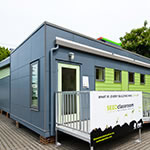The latest idea from Stacy Smedley (this issue’s guest editor) and the team behind Seattle’s Bertschi School Science Classroom is a self-sustaining solution for schools that outgrow their facilities—or for anyone interested in a flexible, living classroom made to last 100 years. The SEEDclassroom, from Smedley’s nonprofit SEED Collaborative, made its debut in May at the Perkins School in Seattle. We chose three words that define its design.
Modular \ˈmä-jə-lər\ adj.

A SEEDclassroom comes with a living wall fed by greywater through a visibly exposed system that students can observe in action.
Constructed with standardized units or dimensions for flexibility and variety in use. SEEDclassrooms are especially efficient usages of time, energy, and materials because of their modular specifications. They can be rescaled, custom fit to meet space requirements, and transported anywhere accessible by road.
Insulation \ˌin(t)-sə-ˈlā-shən\ noun
A material or substance that is used to stop heat, electricity, or sound from going into or out of something. They may not look like the warmest rooms from the inside, but SEEDclassrooms are equipped with triple-paned windows, R-49 ceilings, and R-40 walls, ensuring beyond-sufficient insulation that is 30 percent above code.
Educate \ˈe-jə-ˌkāt\ verb
To give (someone) information about something, or to train (someone) to do something. The SEEDclassroom isn’t just designated for teaching; it’s a teacher too. All of its systems, from the greywater-drinking living wall to the composting toilet, are exposed and labeled to educate students on exactly how they help the structure achieve net-zero energy and water—and what those things actually mean.

